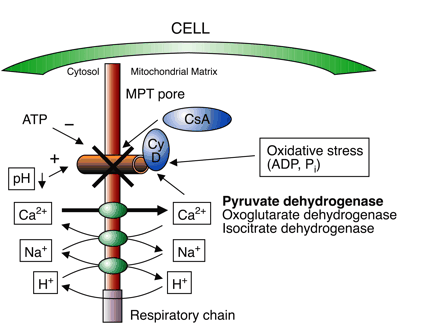
- Institution: Stanford Univ Med Ctr Lane Med Lib/Periodical Dept/Rm L109
- Sign In as Member / Individual
Biochemical Mechanisms of Cyclosporine Neurotoxicity

Factors regulating mitochondrial permeability transition (MPT) pore opening. Oxidative stress, an increase in ADP, low pH, or Ca2+ over-load in the mitochondrion during I/R injury can lead to the opening of the MPT pore. Cyclophilin D (Cy D) is an active part of the MPT pore; binding of cyclosporine (CsA) to its immunophilin can prevent the MPT pore opening. Proposed mechanisms in normoxia: cyclosporine increases intramitochondrial Ca2+ (probably by binding calcineurin), increases oxidative stress, and decreases oxidative phosphorylation and activity of the Krebs cycle enzymes (pyruvate dehydrogenase, oxoglutarate dehydrogenase and isocitrate dehydrogenase, as shown in the figure). Cyclosporine mimics hypoxia by derailing respiratory chain, increasing ROS, and decreasing ATP and triggers an opening of the MPT pore ⇒ mitochondrial toxicity. Proposed mechanisms in I/R injury: cyclosporine binds to cyclophilin D and inhibits MPT pore opening triggered by external oxidative stress ⇒ protection. Interestingly, cyclosporine limits its own toxicity by inhibiting these very same effects through inhibition of cyclophilin D. Cyclosporine inhibits the MPR pore opening and therefore antagonizes its own effects on ATP deterioration and ROS production.


